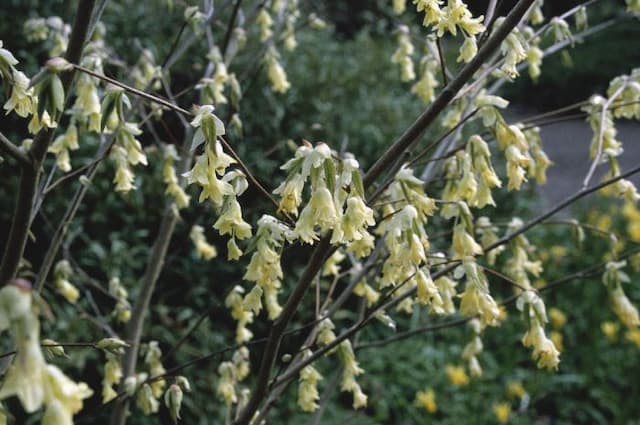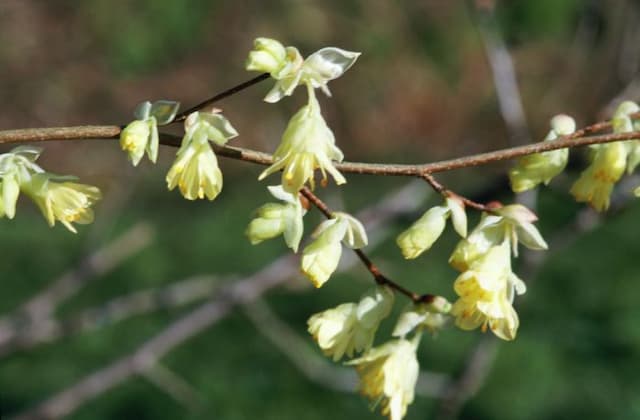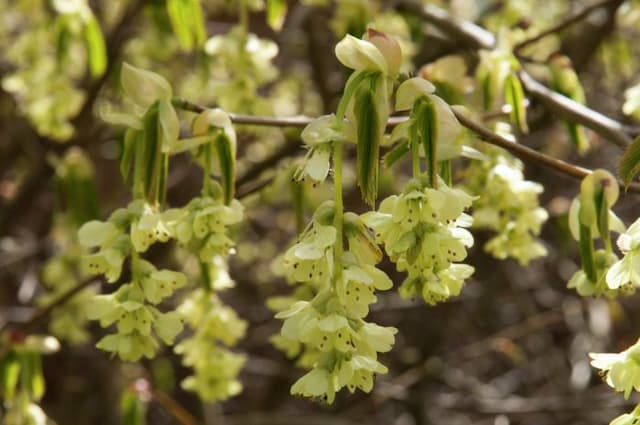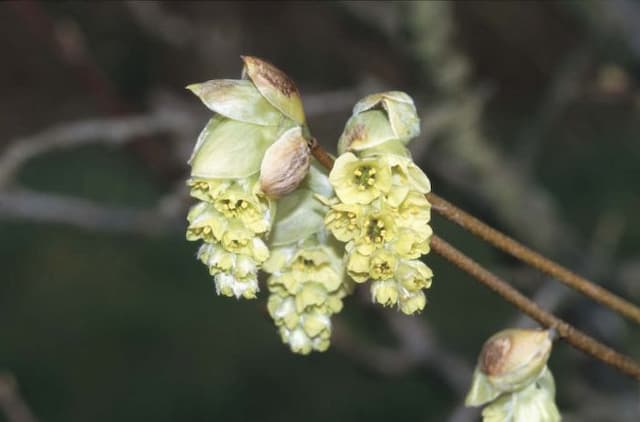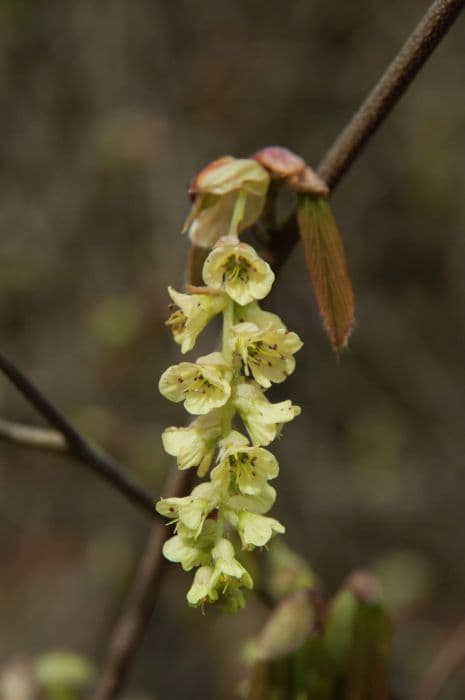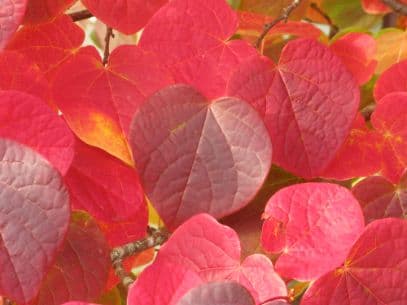Chinese witch hazel Hamamelis mollis 'Imperialis'

ABOUT
The plant in question, commonly known as Chinese witch hazel, is a captivating variety celebrated for its unique and showy late winter to early spring flowers. These blossoms are distinctive, with long, ribbon-like petals that tend to curl and twist, giving the plant an exuberant and slightly unruly appearance when in bloom. The flowers are commonly vibrant yellow, exuding a sweet, spicy fragrance that can be a delight in the otherwise dormant garden. Chinese witch hazel boasts broad leaves that develop a bright green color in the growing season before transitioning to a vivid array of yellow, orange, and red hues as the season changes to fall. These leaves have a certain softness when young, leading to the specific naming of this variety. The overall form of the plant is open and vase-shaped, giving it an airy feel. Whether in flower or displaying its colorful foliage, Chinese witch hazel remains a striking specimen in the landscape.
About this plant
 Names
NamesFamily
Hamamelidaceae
Synonyms
Chinese Witch Hazel, Imperial Witch Hazel
Common names
Hamamelis mollis 'Imperialis'
 Toxicity
ToxicityTo humans
Witch hazel is generally considered non-toxic to humans. However, it is always possible for individuals to have allergic reactions or sensitivities to any plant. Ingesting witch hazel in large quantities might potentially cause stomach upset, but there are no well-documented cases of poisoning from consuming witch hazel plants.
To pets
Witch hazel is also not known to be toxic to pets. As with humans, individual animals may have different sensitivities, and consuming large amounts could lead to gastric distress, but it is not known to cause serious poisoning in pets. It is always advisable to monitor pets around plants and prevent them from eating significant quantities of any non-food plants.
 Characteristics
CharacteristicsLife cycle
Perennials
Foliage type
Deciduous
Color of leaves
Green
Flower color
Yellow
Height
12 feet (3.66 meters)
Spread
10 feet (3.05 meters)
Plant type
Shrub
Hardiness zones
5
Native area
China
Benefits
 General Benefits
General Benefits- Aesthetic Appeal: Chinese witch hazel 'Imperialis' offers vibrant yellow flowers that provide a splash of color in the winter garden when most other plants are dormant.
- Fragrance: The flowers emit a pleasant, spicy fragrance that can add a sensory dimension to the landscape.
- Wildlife Attraction: Its flowers can attract pollinators such as bees, contributing to the health of your garden's ecosystem.
- Seasonal Interest: Blooms in late winter or early spring, providing interest during a time when few other plants are flowering.
- Drought Tolerance: Once established, it is relatively drought-tolerant, requiring less water than some other ornamental plants.
- Low Maintenance: Requires minimal pruning and is generally free from major pests and diseases, making it a low-maintenance option for gardeners.
- Adaptability: Can be grown in a variety of soil types, although it prefers well-drained, acidic soil.
- Versatility: Suitable for a range of landscaping uses, including specimen planting, border accent, and woodland gardens.
- Multi-Season Interest: In addition to winter blooming, it can offer attractive foliage and structure throughout the year.
- Natural Privacy Screen: With its bushy growth habit, it can be used to create privacy screens or hedges in the garden.
 Medical Properties
Medical PropertiesThis plant is not used for medical purposes.
 Air-purifying Qualities
Air-purifying QualitiesThis plant is not specifically known for air purifying qualities.
 Other Uses
Other Uses- Photography: Witch Hazel branches can be used for staging and composition in still-life photography because of their distinctive blossoms.
- Floral Art: Witch Hazel branches can be incorporated into floral arrangements or used as a focal point in ikebana, the Japanese art of flower arranging, due to their unique form and flowers.
- Textile Dye: The leaves and bark of Witch Hazel can be used to create natural dyes for textiles, imparting hues of yellow or orange.
- Garden Structure: During the winter months, the bare, sculptural branches of Witch Hazel can add structural interest to a garden when most other plants have died back.
- Holiday Decor: The bright yellow flowers of Witch Hazel can be used in wreaths and centerpieces as a natural decoration for fall and winter holidays.
- Insect Attraction: Witch Hazel can be planted to attract beneficial insects to the garden, such as pollinators during its flowering season.
- Educational Use: Due to its early flowering, Witch Hazel can be used in educational programs to teach about plant phenology and seasonal changes in plants.
- Craft Material: The unique seed pods and branches of Witch Hazel can be used in crafting, such as making handmade jewelry or decorative items.
- Fragrance Extraction: The flowers of Witch Hazel can be used in the process of making potpourri or scented sachets for their light, spicy scent.
- Cultural Practices: Witch Hazel has its place in various cultural gardening practices, such as Feng Shui, for its symbolism and supposed energy-benefitting properties.
Interesting Facts
 Feng Shui
Feng ShuiThe Witch Hazel is not used in Feng Shui practice.
 Zodiac Sign Compitability
Zodiac Sign CompitabilityThe Witch Hazel is not used in astrology practice.
 Plant Symbolism
Plant Symbolism- Early Blooming: Hamamelis mollis 'Imperialis', commonly known as Witch Hazel, often blooms in late winter or early spring, symbolizing the anticipation of new beginnings and the resilience to endure harsh conditions.
- Healing: Witch Hazel has been used medicinally for centuries, representing healing and the soothing of ailments, both physically and emotionally.
- Protection: Due to its use in traditional medicine and its association with nature's cycles, Witch Hazel can symbolize protection and care, especially in terms of guarding against illness or adversity.
- Uniqueness: The distinctive, spidery flowers of Witch Hazel are emblematic of uniqueness and standing out from the crowd, symbolizing individuality and the celebration of one's own distinctiveness.
- Purity: With its bright, fragrant flowers, Witch Hazel is seen as a symbol of purity and cleanliness, harkening back to its cleansing properties in traditional uses.
 Water
WaterWitch Hazel 'Imperialis' prefers moist but well-drained soil. During the growing season, water this plant deeply once a week, allowing the soil to partially dry out between waterings. Each watering should consist of approximately 1-2 gallons, depending on the size of the plant and the weather conditions. During hot and dry periods, increase the frequency to twice a week. In the winter, reduce watering to match the plant's decrease in active growth.
 Light
LightWitch Hazel 'Imperialis' thrives best in full sun to partial shade. The ideal location would be a spot that receives morning sunlight and dappled shade in the afternoon, protecting it from the intense midday sun. Placing the plant in an area with east or west exposure is optimal to meet its light requirements.
 Temperature
TemperatureWitch Hazel 'Imperialis' can endure a temperature range from about -10°F to 100°F, making it a hardy choice for many climates. The ideal temperature range for promoting healthy growth and flowering is between 30°F and 75°F. It is important to protect the plant from extreme cold and heat outside of the aforementioned range to prevent damage.
 Pruning
PruningWitch Hazel 'Imperialis' benefits from pruning to maintain shape and encourage vigorous growth. Pruning should be done in late winter or early spring before new growth begins. Remove any dead or crossing branches and thin out older stems to promote air circulation. The plant may also be lightly pruned after flowering to enhance its appearance, though this is not strictly necessary.
 Cleaning
CleaningAs needed
 Soil
SoilChinese witch hazel thrives in a well-draining, loamy soil rich in organic matter. A soil pH of 5.5 to 6.5 is ideal for optimal growth. Amend the soil with compost or peat moss to improve fertility and structure before planting.
 Repotting
RepottingChinese witch hazel does not need frequent repotting. It should be repotted only when it has become root-bound, which may take several years. Generally, repotting every 3 to 5 years is sufficient.
 Humidity & Misting
Humidity & MistingChinese witch hazel prefers moderate to high humidity levels. To maintain optimal humidity, ensure the area around the plant is well-ventilated and avoid placing it in overly dry environments.
 Suitable locations
Suitable locationsIndoor
Provide bright, indirect light and ensure high humidity.
Outdoor
Plant in partial shade and shelter from strong winds.
Hardiness zone
5-8 USDA
 Life cycle
Life cycleHamamelis mollis 'Imperialis', commonly known as Chinese witch hazel, begins its life cycle when a seed germinates, usually requiring stratification to break dormancy. Once the seed sprouts, the seedling grows into a young plant, developing a fibrous root system and foliage. As the plant matures, it forms a rounded to vase-shaped shrub with broad, oval green leaves. Chinese witch hazel 'Imperialis' is notable for its winter flowering; fragrant, ribbon-like, yellow to rust-orange flowers bloom on bare branches from midwinter to early spring. After pollination, typically by early-season insects, the plant produces seed capsules that mature and split open in the fall, dispersing seeds to begin a new cycle. Throughout its life, the shrub undergoes seasonal changes, with leaves turning yellow to orange in the fall before dropping, entering a period of dormancy during the winter months.
 Propogation
PropogationPropogation time
Spring
The most popular method of propagating Witch Hazel (Hamamelis mollis 'Imperialis') is through softwood cuttings. This technique is usually carried out during late spring to early summer when new growth is still green and pliable. A healthy, non-flowering shoot is selected and a cutting approximately 4 to 6 inches long is taken with a clean, sharp pair of shears. The lower leaves are stripped, and the cut end may be dipped in rooting hormone to encourage root development. The cutting is then placed in a well-draining potting mix, ensuring at least two nodes are buried where leaves were removed. The pot should be kept in a warm location with indirect light and maintained with consistent moisture. Roots typically develop after a few weeks, at which point the cutting can gradually be acclimatized to less protective conditions before eventual transplanting.
